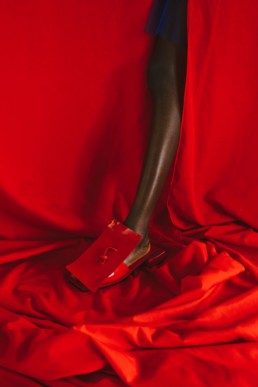“Land of gods”, Inspired by Yoruba and Edo Mythology, which are both complex but yet so similar. This collection continues our scope into examining and understanding us beyond being human beings through the idea of divinity. We create and destroy are we gods or descendants of gods? The self participates in everyday life in agbon (the visible world) and in erinmwin (the spirit world also known as the world of the ancestors) which is home to ones spiritual guardian (Ehi). Power resides in ones own head (uhunmwun) and in ones Ehi with whom the head cooperates with. Ones head can either curse or bless ones actions. The Edo place themselves at the center of creation: Edo ore I se agbon – Edo the land that extended to the visible world. The Edo refer to themselves as Ivbi Oto children of the land.
Our Ehi is like the clothes you wear. All of you is a ritual space, your body is a temple. Your body becomes a spiritual landscape, that is the energy field, designed, constantly reworked and reactivited. You design what you wear. The art of the idea of divinity spans around the term Osa in Edo (Orisa in Yoruba) a spiritual mindset based on the notion of family, the large family descended from a single ancestor, encompassing both living and deceased. By establishing certain ties in divinity they are able to control certain forces of nature. Without love, faith and dignity one can never penetrate the mystery of knowing what Osa is. It is everything in human life. It’s in positive energy, water, leaves, the earth; it is real.
The spirit of human individuality is visual, oral and musical rather than written. Like a spirit, it can’t stay still; it’s constantly in motion.
There are 3 fundamental colours used in this collection, red signifying blood, fire, provocation, sacrifice and violence, black signifying shame and white which signifies joy and purity these are the colours of the spiritual command Àse, the vital energy. This collection honors the age-old tradition of the making of the “Adaigho” the spiritual garment worn by high priests and priestess. In every pattern of this collection a message is conveyed, linking our craft experiences to the meaning of ceremonial dressmaking as a gesture of prayer, a vehicle of communication with the spirit world.
Cloth is the important indication of numinous presence in the worship of the moral inquisitors.
Pieces were made in infinite layered sheer recycled polyester ruffles as a sign of abundance and mastery in the spirit world. Highlighting one important symbol in Edo which is Igha-ede (that divides the day) in our beading patterns mirroring a simple cross design with circles, translating into many ways such as the transmission of messages to and from the spirit world as well as the division of earthly and spiritual realms. Like the borders in land, nature was articulated angularly. Seen and unseen, Opportunity and threat, dry and wet, day and night, back and forth, warp and weft.
The spirits see all sides of a person.
These pieces are terrains of soul, never finished, a language for the body beyond conscious understanding, like a mnemonic device that reminds you of what we’ve always known. A road map to the truth, Created with atisans in Lagos, Osun, Edo and Kano states in Nigeria,
We collaborated with Nigerian shoe designer, Kkerele to create the shoe collection made from patent cow leather.
Creative Direction Bubu Ogisi
Photography Chris Okoigun
Model Adejoke Adesope






